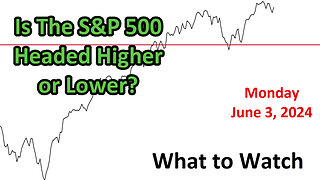Free Stock Market Course Part 37: SPX Analysis
Free File downloads
Course notes, Audio files, Assessments, Transcript files, and Course Outline: https://spxinvestingblog.com/downloads/
My Exclusive Free Workshop The Four P's of Building a Successful Investing Program → https://spxinvesting.mailchimpsites.com
Blog: https://spxinvestingblog.com
Facebook Public Group: https://www.facebook.com/groups/433843641082343
Chapters:
00:00 SPX Analysis
02:40 SPX Analysis Tools
05:11 SPX Indicators
12:06 Intraday Analysis
22:07 SPX Studies
26:45 Additional SPX Studies
31:39 Broader Market Studies
34:06 The Goal
Module 5 Section 10
SPX Analysis
One of the benefits of studying a broad Index comprised of high-quality stocks is that lots of information and studies are available.
Indicators that are unique to Indexes, including the SPX, can be used for analysis.
Decisions can be made using a broad-range of Tools, Indicators, and Analysis.
This can also be daunting and can cause information overload, which can produce indecisiveness.
The idea is to reach a “consensus.” Hence, The Consensus Approach.
SPX Analysis Tools
Intermarket Analysis
Technical Analysis
Dow Theory based on the SPX Indexes
Performance comparison with other indexes
Indicators based on:
Price
Volume
Price & Volume
SPX Indicators
Advancing & Declining issues Indicators based on:
Price, Volume, Price & Volume
Price and Volume Indicators within the SPX to determine if movement is:
Broad-based
Confined to a limited number of “bigger” stocks
Sentiment Indicators
Put/Call Ratios
Volatility Measurements
Inflows & Outflows
Optimism and Pessimism Indicators
McClellan Oscillator & Summation Index Analysis
Price Momentum Oscillator Analysis
Intraday Analysis
Each day, the SPX and SPY are analyzed while the market is open using real-time data.
Intraday Charts include:
10 Minute
30 Minute
60 Minute
Other time-frames are used when deemed applicable.
Intraday Analysis allows for understanding:
Support and Resistance levels (Pivot Points)
The intensity & velocity of price movement.
Gap- Analysis and reaction
Useful as the final variable used for entering or exiting a position:
Enter a position if the market is moving in the direction of the strategy.
Enter as close to the close as possible.
SPX Studies
New Highs versus New Lows Studies
Relative Strength Studies
Sector Strength or weakness
Comparison with other Indexes
Overbought and Oversold Indicators
Oscillators and stand-alone indicators
Performance Studies for:
Short, Intermediate and Long Term Studies
Multiple Time Frame Studies (Daily, Weekly, Monthly)
Trend & Momentum Studies
MA Studies
Trend condition Studies
Additional SPX Studies
Bullish Percent Index & Point and Figure Studies
Earnings & Dividend Studies
Various Chart Studies (Kagi, Renko, three-line break)
Parabolic SAR Studies
Volume & Participation Studies
Fibonacci Studies
Elliot Wave Studies
Algorithmic Studies
Sector Analysis Studies
Broader Market Studies
Studies of other Indexes (Ratios, Convergences & Divergences)
Domestic and Foreign
Small, Mid and Large Cap Indexes
Arms Index Studies & TRIN Analysis Studies
Dow Theory Studies
Advance-Decline/Line Studies
TICK Analysis Studies
Volume Analysis Studies
World Bond Index Studies & Comparisons
World Stock Index Studies & Comparisons
The Goal
The ultimate goal is to use all of this information together in order to make the best decisions possible.
Some days will reinforce a previous conclusion.
Other days will require waiting for more information to provide a clearer picture.
Yes, doing nothing is also part of investing.
The main objective is to not get caught off-guard.
A plan should be developed for all three scenarios:
If the SPX:
1. Goes up
2. Goes down
3. Goes sideways
-
 44:44
44:44
The SPX Investing Program
8 hours agoS&P 500 What to Watch for Tuesday June 3, 2024
291 -
 4:48:29
4:48:29
LumpyPotatoX2
5 hours ago$10,000 PUBG Tournament w/GamersError - #RumbleTakeover
6.19K2 -
 3:22
3:22
One Bite Pizza Reviews
2 days agoBarstool Pizza Review - Marco Pizzeria & Restaurant (Branford, CT)
12K19 -
 41:46
41:46
Standpoint with Gabe Groisman
9 hours agoEp. 27. From GameStop to the NBA. Gabe Plotkin
14.3K3 -
 55:04
55:04
Matt Kohrs
6 hours agoThe Volatile Week Ahead || The MK Show
30K10 -
 26:18
26:18
Stephen Gardner
6 hours agoTop Republican UNLOADS on Democrats and Biden's MENTAL HEALTH!!
37.5K57 -
 44:30
44:30
Michael Franzese
2 days agoCancel Culture Backlash of My UK Tour | Michael Franzese
95.8K48 -
 35:12
35:12
Island Hopper TV
1 day agoFull Costa Rica Travel Guide 2024
55.8K32 -
 4:43
4:43
ParisDemers
1 day agoThis Diet Hack Changed My Life! (How To Get Ripped FAST!)
69.8K29 -
 46:57
46:57
Crime Circus
1 day agoApple River ST*BBING!! Stand Your Ground Interrogation of Man in Wisconsin
71.1K45